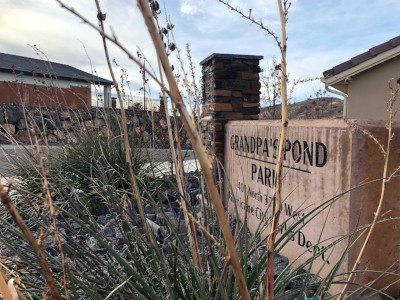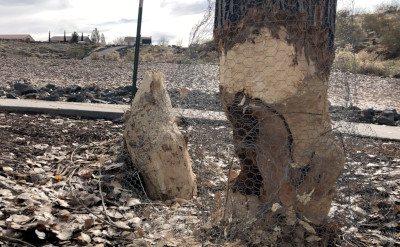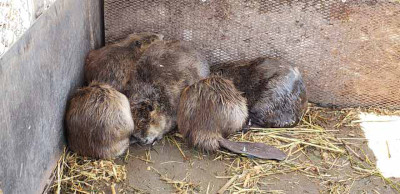ST. GEORGE — Last year, the Utah Division of Wildlife Resources relocated several beavers from the popular recreation area known as Grandpa’s Pond to remote places of Utah for wetlands restoration projects.

St. George News made a recent trip to the public park, known for a level half-mile trail that loops a pond filled with birds of multiple species, located five miles southwest of Hurricane. At least two new trees are gone, the stumps showing large teeth marks and several more trees are wrapped in chicken wire fencing after being damaged. It seems the beavers didn’t want to leave.
Utah Division of Wildlife Resources Wildlife Program Manager Teresa Griffin confirmed state officials are working with Hurricane City Parks and Recreation staff on a solution for the current problem of beavers at Grandpa’s Pond. Beavers are often trapped and relocated by wildlife officials in Utah. When this happens, the animals receive a small antenna implant for tracking purposes, if they are large enough, Griffin said.
“None of these beavers are ones we have trapped in the past,” she said said of the beavers at Grandpa’s Pond. “We moved most of the beavers up near Bryce Canyon to a remote area near the Sevier River, or another site where they were horse-packed into the Pine Valley wilderness to help repair the damaged watershed after a fire that occurred about four years ago.”
The semi-aquatic mammal thrived in the desert climates of Southern Utah long before pioneer settlers arrived, living among lizards, tortoises, and rattlesnakes, said Geoffrey Smith, assistant professor of biology at Utah Tech University. He’s encountered them as far south as the Grand Canyon.
“Beavers are definitely here and have been in larger numbers historically,” he said. “Beaver Dam Wash got its name from Jefferson Hunt in 1847. They were almost hunted out in a lot of the continent, and dredging wetlands and rerouting streams for irrigation have reduced their habitat. So they’re around here, but not abundant.”

In Utah, beaver trapping was made illegal in 1899. Land and business owners have been able to apply for a permit to have state wildlife officials trap and relocate nuisance animals from their property since 1974.
Besides Grandpa’s Pond, the Division of Wildlife Resources currently has permit requests to remove beavers from both Sunbrook and Southgate golf courses in St. George, Griffin said. And trapping animals in public places can be difficult.
“Grandpa’s Pond has some complicated issues since it frequently has people and dogs nearby,” she said. “So if we did set a live trap in the area, it would be somewhat dangerous because of the spring-loaded nature of the live traps.”
Thomas Biebighauser, a wildlife biologist and wetland ecologist for Wetland Restoration and Training, completed more than 6,000 wetland restoration projects in many states, including Utah, during his career spanning four decades. From his home in Kentucky, he said that while beavers present problems for many landowners, they are also great for the surrounding habitat.
Many residents in the western United States think of a river and picture two sloping hills of sand with water running between them, eroding the soil as it rushes by, Biebighauser said. But, before European pioneers began tearing out beaver dams nearly two centuries ago, tributaries such as the Virgin River had banks with lush green grasses, trees, wildlife, and flowed much slower.

“Beavers used to be prevalent coast-to-coast, and they are really what fueled the colonization of the west,” he said. “After their numbers decreased due to trapping and loss of habitat, many states banned killing beavers. Now, many years later, their numbers are rebounding and people are starting to see them in places they never have, like golf courses.”
Many times he was watched as owners buy a secluded property with a stream, then spend both time and money lining the stream with expensive trees. The beavers love this, the property owners are usually “not so happy with the end result.”
“But if you love to fish, beaver ponds are great places for trout to reproduce,” Biebighauser said. “If you love to watch birds, you will see ducks, geese, herons, and many new species you have probably never seen. These ponds also reduce the chances of severe flooding and they restore groundwater by recharging the aquifer. I know many ranchers who have grown to love them once they realize the benefits.”
Griffin said property owners can wrap a tree’s base in chicken wire to stop beavers from chomping on them, but if problems persist they can apply for a removal permit. In rare cases, a lethal permit may be issued.
“With the proximity of the Virgin River, it may be an on-going problem,” she said. “It seems wildlife really enjoy the nice parks we intend for humans.”
Both Griffin and Biebighauser said those hoping to see a beaver at Grandpa’s Pond would have the best opportunity at sundown, and walk quietly. Those who get spooked by a loud sound may have lost their chance.
“It will sound like a gunshot — it will be loud,” Biebighauser said. “That is the sound of a beaver’s tail slapping the water to warn others of danger.”
Photo Gallery

Evidence can be seen of beaver activity at Grandpa’s Pond in Hurricane on Friday, Jan. 13, 2023 | Haven Scott, St. George News

Beavers that are routinely trapped and relocated by Utah’s Division of Wildlife Resources are shown in this undated photo | Utah Division of Wildlife Resources, for St. George News

Utah Division of Wildlife Resources staff are shown relocating beavers in this undated photo | Utah Division of Wildlife Resources, for St. George News

An artificial beaver dam used to replicate the wetlands that are vital for several ecosystems is shown in an undisclosed location on November 17, 2020 | Utah Division of Wildlife Resources, for St. George News
Copyright St. George News, SaintGeorgeUtah.com LLC, 2023, all rights reserved.